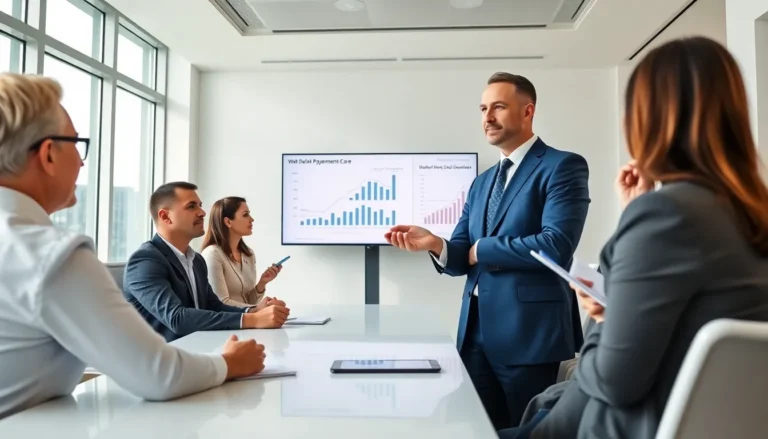Table of Contents
ToggleEver wondered why the price of your favorite coffee keeps rising while your paycheck seems stuck? Welcome to the captivating world of economic trends, where seemingly random numbers tell a story about the health of our economy. Forget boring textbooks: let’s tackle this topic with a touch of humor while unpacking the vital signals your wallet needs to keep an eye on. So grab your favorite brew and settle in, because we’re about to get real about the forces shaping the economy.
Understanding Economic Trends

Economic trends are patterns that indicate the direction of an economy over time. They represent the collective movements of economic indicators, including GDP growth, unemployment rates, inflation, and consumer spending. These trends can last for months, years, or even decades, much like that old couch you’ve been meaning to replace. Understanding these trends is crucial because they help citizens, businesses, and governments make informed decisions. They show where the economy is headed, and more importantly, they alert us to potential changes in our financial environments.
Types of Economic Trends
There are several essential types of economic trends to consider:
1. Short-term Trends
These trends typically last from a few months to a year. They can be driven by seasonal changes, like holiday shopping spikes, or unexpected events, like natural disasters or policy changes.
2. Long-term Trends
Unlike their short-term counterparts, long-term trends evolve over many years. They often signal structural shifts in the economy, such as technological innovations that transform industries. Think mobile banking completely changing how we handle money.
3. Cyclical Trends
Cyclical trends are tied to the business cycle, with periods of expansion and contraction. This is when recessions come into play, no one enjoys a downturn, but understanding them can help businesses navigate through the storm.
4. Secular Trends
These are the slow, long-term shifts that shape the economy permanently. Examples include demographic changes like aging populations or shifts in consumer preferences toward more sustainable products.
Factors Influencing Economic Trends
Several key factors influence economic trends:
1. Consumer Behavior
Changes in how consumers spend their money can have significant ripple effects throughout the economy. The rise of e-commerce, for instance, has altered retail landscapes drastically.
2. Government Policies
Policies about taxation, trade, and spending can either stimulate growth or stifle it. For example, new tariffs might protect domestic producers but frustrate consumers with higher prices.
3. Technological Advances
From the industrial revolution to the digital age, technology plays a pivotal role in shaping economic trends. Automation and artificial intelligence are disrupting labor markets and productivity.
4. Global Events
Economic trends are often influenced by global occurrences. Events like pandemics or geopolitical tensions can create shifts in market confidence, impacting everything from oil prices to tourism.
How to Analyze Economic Trends
Analyzing economic trends can seem daunting at first, but it boils down to a few practical steps.
1. Identify Key Indicators
Focus on indicators like GDP, inflation, and unemployment rates. Each of these can provide a snapshot of economic health and direction.
2. Use Economic Reports
Leverage reports from reliable sources like the Federal Reserve or the Bureau of Economic Analysis. These documents offer insights and forecasts based on comprehensive data.
3. Stay Informed
Keeping up with current events and news can enhance understanding of underlying trends. Whether it’s a change in interest rates or an emerging industry, staying updated is key.
4. Employ Analytical Tools
Consider using software or platforms that provide analytical tools for tracking economic indicators over time. Charts, graphs, and visual data can help interpret trends at a glance.
Impact of Economic Trends on Businesses and Consumers
Economic trends can dramatically affect both businesses and consumers.
1. Impact on Businesses
Businesses rely heavily on economic trends to make strategic decisions. For example, rising inflation might lead a company to increase prices or reassess its supply chain management.
2. Consumer Spending
For consumers, trends influence everything from job security to purchasing power. An interest rate hike means higher loan costs, which can curb consumer spending, impacting businesses relying on sales.
3. Market Opportunities and Risks
Both parties can identify opportunities or risks based on economic trends. A booming economy might encourage businesses to expand, while a recession could lead to cutbacks and job losses.
Current Economic Trends to Watch
As of now, several economic trends are capturing attention:
1. Inflation Rates
With inflation remaining a hot topic, watching the numbers can help gauge potential future economic conditions. Cost of living adjustments are always a concern for consumers.
2. Labor Market Shifts
The workforce is evolving, with more remote jobs becoming standard fare. Employers must adapt to attract the right talent.
3. Sustainability in Business
Companies are increasingly embracing sustainability, influenced by a growing consumer preference for environmentally friendly products. Corporate social responsibility is becoming a competitive edge.








